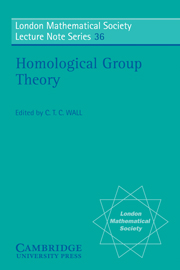Book contents
- Frontmatter
- Contents
- Preface
- Introduction
- 1 Traces and Euler characteristics
- 2 Groups of virtually finite dimension
- 3 Free abelianised extensions of finite groups
- 4 Arithmetic groups
- 5 Topological methods in group theory
- 6 An example of a finite presented solvable group
- 7 SL3(Fq[t]) is not finitely presentable
- 8 Two-dimensional Poincaré duality groups and pairs
- 9 Metabelian quotients of finitely presented soluble groups are finitely presented
- 10 Soluble groups with coherent group rings
- 11 Cohomological aspects of 2-graphs. II
- 12 Recognizing free factors
- 13 Trees of homotopy types of ( m)-complexes
- 14 Geometric structure of surface mapping class groups
- 15 Cohomology theory of aspherical groups and of small cancellation groups
- 16 Finite groups of deficiency zero
- 17 Äquivalenzklassen von Gruppenbeschreibungen, Identitäten und einfacher Homotopietyp in niederen Dimensionen
- 18 Two-dimensional complexes with torsion values not realizable by self-equivalences
- 19 Applications of Nielsen's reduction method to the solution of combinatorial problems in group theory: a survey
- 20 Chevalley groups over polynomial rings
- List of problems
19 - Applications of Nielsen's reduction method to the solution of combinatorial problems in group theory: a survey
Published online by Cambridge University Press: 05 April 2013
- Frontmatter
- Contents
- Preface
- Introduction
- 1 Traces and Euler characteristics
- 2 Groups of virtually finite dimension
- 3 Free abelianised extensions of finite groups
- 4 Arithmetic groups
- 5 Topological methods in group theory
- 6 An example of a finite presented solvable group
- 7 SL3(Fq[t]) is not finitely presentable
- 8 Two-dimensional Poincaré duality groups and pairs
- 9 Metabelian quotients of finitely presented soluble groups are finitely presented
- 10 Soluble groups with coherent group rings
- 11 Cohomological aspects of 2-graphs. II
- 12 Recognizing free factors
- 13 Trees of homotopy types of ( m)-complexes
- 14 Geometric structure of surface mapping class groups
- 15 Cohomology theory of aspherical groups and of small cancellation groups
- 16 Finite groups of deficiency zero
- 17 Äquivalenzklassen von Gruppenbeschreibungen, Identitäten und einfacher Homotopietyp in niederen Dimensionen
- 18 Two-dimensional complexes with torsion values not realizable by self-equivalences
- 19 Applications of Nielsen's reduction method to the solution of combinatorial problems in group theory: a survey
- 20 Chevalley groups over polynomial rings
- List of problems
Summary
In this paper we use the terminology and notation of [12] and [51]. One finds there the concepts and results concerning combinatorial descriptions of groups which are used (but not always further explained) below.
THE NIELSEN REDUCTION METHOD IN AMALGAMATED FREE PRODUCTS AND HNN GROUPS
One of the most important methods in the theory of free groups and some similar groups, is the Nielsen reduction method. If F is the free group with free generators a, b, … one can define a notion of free length L in F (relative to the generators a, b, …) and a certain lexicographical ordering. The Nielsen reduction method in F concerns Nielsen transformation from systems {gj}jϵJ to systems which are shorter with respect to the length L and ordering (cf. [21], [22], [54]).
If we apply this method to a finite system {x1, …, xm}, we arrive after a finite number of steps at a system in which no element and no inverse of an element can shorten another by more than half, and no two can shorten another to nothing - i. e. a system which possesses the Nielsen property with respect to L. Nielsen ([21], [22]) used the property for the proof that subgroups of free groups are free. To be sure, one cannot define a meaningful length function in every group (cf. [4], [8], [13]). A length satisfying certain ‘natural’ axioms exists essentially only in free products.
- Type
- Chapter
- Information
- Homological Group Theory , pp. 339 - 358Publisher: Cambridge University PressPrint publication year: 1979
- 2
- Cited by



